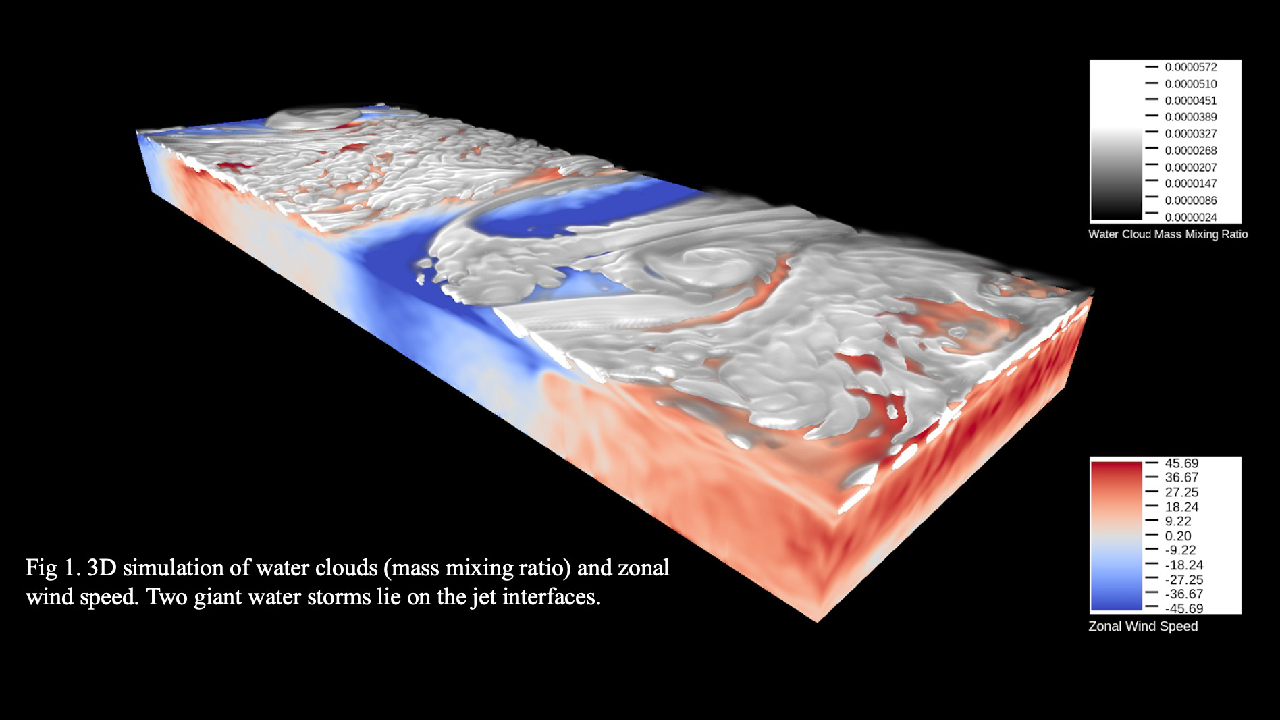Cloud-Resolving Simulation of Moist Convection in Jupiter’s Atmosphere
- 1Department of Earth and Planetary Science, University of California Santa Cruz, Santa Cruz, California, USA (huazhige@ucsc.edu)
- 2Department of Climate and Space Sciences and Engineering, University of Michigan, Ann Arbor, Michigan, USA (chengcli@umich.edu)
- 3Department of Earth and Planetary Science, University of California Santa Cruz, Santa Cruz, California, USA (xiz@ucsc.edu)
- Introduction
Moist convection is ubiquitously present in Jupiter’s atmosphere albeit the least understood. Many fundamental questions regarding planetary atmospheres are closely related to moist convection. For example, lightning events are more frequently detected in Jupiter’s belts where the visible layer is dryer and cloudless [1, 2, 3]; chemically inert vapor like ammonia is not uniformly mixed well below its condensation level. To address those puzzles, we create a new Jovian atmospheric model (SNAP) [4], using the vertical-implicit-correction (VIC) scheme [5]. The VIC scheme greatly improves the computational efficiency for simulations with a large horizontal-to-vertical aspect ratio. For a typical synoptic-scale simulation, the efficiency is improved by about 2 orders of magnitudes. We present a beta-plane simulation relevant to Jupiter’s regimes with condensation of water and ammonia to study jet and vortex formations in the mid-latitude. Several cyclones, resembling hurricanes in Earth's atmosphere, are found at the interfaces of eastward jets and westward jets in the water cloud layers. Our simulation is the first nonhydrostatic 3D Jovian atmosphere model that explicitly resolves moist convection.
- Model Description
SNAP is developed on top of the framework of Athena++, which is a finite volume astrophysics code [4, 6]. In our recent work, a VIC scheme is implemented into the model [5]. The VIC scheme solves diagnostic variables (i.e., density, velocities, and total energy) of Euler equations by implicitly treating the vertical flux divergence. This treatment greatly relaxes the Courant-Friedrichs-Lewy (CFL) condition in the vertical direction, allowing larger time steps for large horizontal-to-vertical aspect ratio simulations. The detailed description and test cases are present in Ref [5].
- Jupiter Beta-Plane Simulation
We present the result of Jupiter’s beta-plane simulations. The initial condition is set as a uniform moist adiabat across the horizontal plane with water vapor and ammonia vapor. The heavy element abundances are chosen to be 3 times of solar value. We use a linear body cooling scheme to simplify the radiative transfer in Jupiter’s upper troposphere (i.e., above 1 bar pressure level). The bottom temperature is relaxed back to the initial value to mimic the internal heat flux in the real situation. Winds are allowed to evolve in the troposphere freely but are damped in the stratosphere. We tried two scenarios, one with latent heat release from water and ammonia and one without.
Multiple eastward and westward jets are produced in both cases. Fig 1, the result of the moist case, shows that two giant cyclonic storms (i.e., radius ~ 1000 km) are also formed at jets’ interfaces where the eastward jets are in the south, and westward jets are in the north. Such regions are belts in Jupiter’s atmosphere where the fluid motion is cyclonic. In the dry case, we find that, although latent heat is removed from the system (i.e., excluding water and ammonia vapors), there are still multiple jets with the same order of magnitude zonal wind speed, but cyclones vanish. Thus, resembling hurricanes on Earth [7], latent heat from the moist convection supplies the energy to form cyclones in Jupiter’s atmosphere.

- Conclusions
Here, we present the first nonhydrostatic Jovian synoptic-scale moist convection simulation to improve our understanding of Jupiter’s atmospheric dynamics. The mid-latitude beta-plane simulation suggests that jets can be freely evolved in a constant-beta plane. But cyclonic moist storms require latent heat to supply the energy for their formation. The project is still ongoing, and we have already discovered many features that resemble Jupiter’s atmosphere.
Reference:
[1] Becker, Heidi N., et al. Nature 584.7819 (2020): 55-58.
[2] Gierasch, P. J., et al. Nature 403.6770 (2000): 628-630.
[3] Little, Blane, et al. Icarus 142.2 (1999): 306-323.
[4] Li, Cheng, and Xi Chen. The Astrophysical Journal Supplement Series 240.2 (2019): 37.
[5] Ge, Huazhi, et al. The Astrophysical Journal 898.2 (2020): 130.
[6] Stone, James M., et al. The Astrophysical Journal Supplement Series 249.1 (2020): 4.
[7] Holton, James R. American Journal of Physics 41.5 (1973): 752-754.
How to cite: Ge, H., Li, C., and Zhang, X.: Cloud-Resolving Simulation of Moist Convection in Jupiter’s Atmosphere, European Planetary Science Congress 2021, online, 13–24 Sep 2021, EPSC2021-342, https://doi.org/10.5194/epsc2021-342, 2021.

